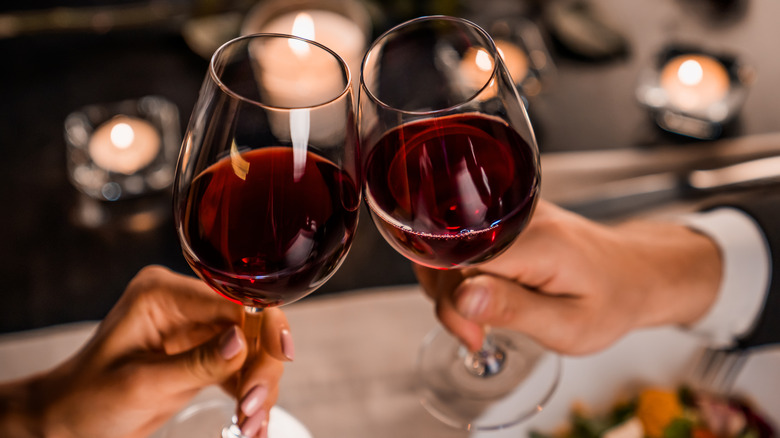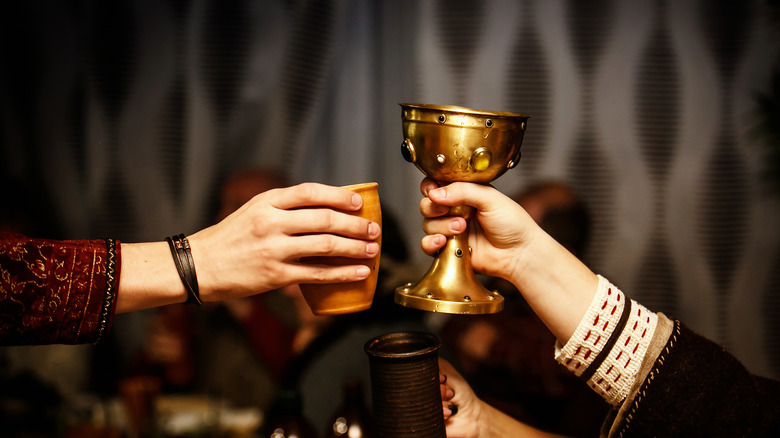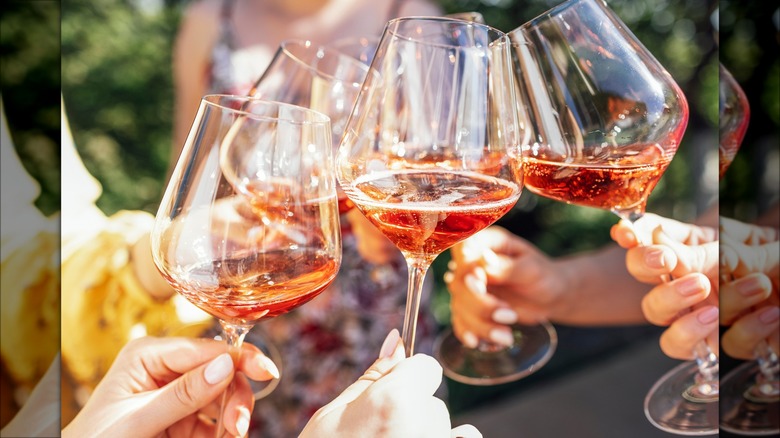Is It Bad Etiquette To Clink Your Wine Glasses?
To clink or not to clink? It's a question that has plagued dinner party guests for ages. In some circles, folks will go as far as to thrust their glass towards you and insist on some contact. In other scenarios, you might start the motion, only to see everyone else simply raise their glasses, forcing you to retract your glass in embarrassment. Etiquette rules are tricky like that — from placing your chopsticks just so, to following the unwritten rules of a winery visit, there are many nuances to grasp.
In the case of wine glass clinking, proper etiquette depends on your environment. When in doubt, look around you to observe what others are doing, but there are some rules of thumb to keep in mind. In formal settings, raising a glass without clinking is more typical, but in more casual settings as well as in certain countries, it's the customary practice. To understand why, it's helpful to know how sharing a toast came to be and where it sits today.
If wine clinking is so improper, why do we do it?
Getting to the bottom of where glass clinking originated is as tricky as opening a bottle of wine with a broken cork. Some posit that clinking began as a show of trust during medieval times, where a forceful tap of goblets or mugs (and often the accompanying slosh and potential exchange of beverage) would signify that no one's drink had been poisoned. Others believe that clinking has spiritual origins, in that the sound of clinking glasses would scare off evil spirits, or splashes of wine on the floor would sate gods or demons.
The reason we clink may have more to do with the fact that it just ... feels good. Some say that adding a clinking sound engages the sense of hearing in the drinking process. A clink with your toast can also be poetic — bringing glasses together is a proleptic gesture to anticipate the coming together of people.
With such well-meaning roots, it can be difficult to see why some still consider the practice of clinking to be improper etiquette. The reasoning has a lot to do with glassware. Especially when fine crystal is involved, as is the case in more formal settings; no one wants to risk a chip in their prized drinkware or worse, the party faux pas of breaking a glass.
If you do want to clink, keep this in mind
In most informal settings today, clinking glasses is both acceptable and amusing. However, there is still some etiquette involved. First, hold your glass by the stem. Not only does it keep your wine at the proper temperature, but it also prevents grubby fingerprints from tarnishing your shiny glass. When you go in for the clink, aim to touch the wide bottom part of your glass (also known as the bell) instead of the rim, as this spot is less prone to breaking and makes a more satisfying chime.
When you travel and toast, etiquette can shift. Different countries and cultures have their own traditions when it comes to clinking. In China, keeping your glass lower than your toast partner shows deference. In places like Germany, France, Spain, Austria, and Italy, eye contact is also key. In Spain, those who fail to make eye contact while toasting are said to be cursed with seven years of lackluster lovemaking. In many of these countries, including Germany, Austria, and Italy, you also shouldn't cross arms with anyone to complete the toast. Despite these variances, and no matter where you are, paying attention to social cues, understanding why clinking is significant to some, and knowing how not to shatter your glass during a toast will help you clink (or not) with confidence.


